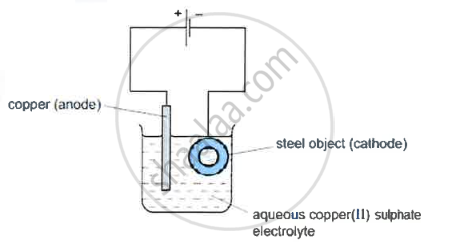Advertisements
Advertisements
प्रश्न
A solution of silver nitrate is a good electrolyte but is not used for electroplating an article with silver.
उत्तर
A solution of silver nitrate is good electrolyte but is not used for electroplat ing an article with silver because, the deposition of silver will be very fast and hence not smooth and uniform.
APPEARS IN
संबंधित प्रश्न
Name the metallic ions that should be present in the electrolyte when an article made of copper is to be electroplated with silver.
Give reasons why In the electroplating of an article with silver, the electrolyte sodium argentocyanide solution is preferred over silver nitrate solution.
Give one word or phrase for the following:
Electrolytic deposition of a superior metal on a baser metal.
Out of Cu and Ag, which is more active?
List out the main applications of electrolysis.
The following question relate to the electroplating of an article with silver.
What should be the nature of the anode?
Copy and complete the following table :
| Anode | Electrolyte | |
| Purification of copper |
Describe what happens to the iron object and the copper rod.
What ions must be present in a solution used for electroplating a particular metal?
Electroplating steel objects with silver involves a three-step process.
Step 1: A coating of copper is applied to the object.
Step 2: A coating of nickel is applied to the object.
Step 3: The coating of silver is applied to the object.
-
- A diagram of the apparatus used for step 1 is shown

- The chemical process taking place on the surface of the object is \[\ce{Cu^2+(aq) + 2e- ->Cu(s)}\]
What is the observation seen on the surface of the object? - Explain why the concentration of copper ions in the electrolyte remains constant throughout step 1.
- The chemical process taking place on the surface of the object is \[\ce{Cu^2+(aq) + 2e- ->Cu(s)}\]
- A diagram of the apparatus used for step 1 is shown
- Give two changes which would be needed in order to coat nickel on to the object in step 2.
- Write down the reaction taking place at the positive electrode during step 3.
